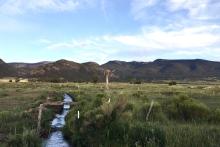In a recent article in Civil Eats, Professor Devon Peña shares his work with The Acequia Institute, which he founded to build environmental sustainability in the Southwest. The acequia system was once dismissed by Western water managers. But as a changing climate brings increasing drought and aridification to the Southwest, time-tested solutions like this one could hold the key to mitigating the worst impacts of climate change, especially in rural communities. “[Water managers] are starting to appreciate us a lot more than they did 20 or 30 years ago when they thought we were backward, primitive, and inefficient,” Professor Peña said.
The word acequia—from the Arabic word “as-saquiya,” which means “that which carries water”—was used to describe the irrigation ditches that evolved in the Middle East and were introduced to the Iberian Peninsula during the Islamic Golden Age. In New Mexico, these systems were often put in place even before a church was built. Acequias operate under the principle of “shared scarcity,” rooted in Islamic law, whereby every living thing has a right to water, and to deny them water is a mortal sin. Water is thus treated as a communal resource to be shared, rather than divvied up and contested. “They all share something in common, which is community governance,” Peña said. “It’s a water democracy.”
In addition, there is a new 1-hour PBS documentary from Colorado filmmakers Alan Domínguez and Raúl Paz-Pastrana that takes you to the heart of the San Luis Valley to explore the critical issue of water and its profound effect on the lives, livelihoods, and future of the region.
The film highlights the tension between large-scale agriculture and more natural, sustainable approaches to land management. You’ll learn about the importance and resilience of traditional acequia irrigation systems, and how they've adapted to the challenges of a changing climate.
